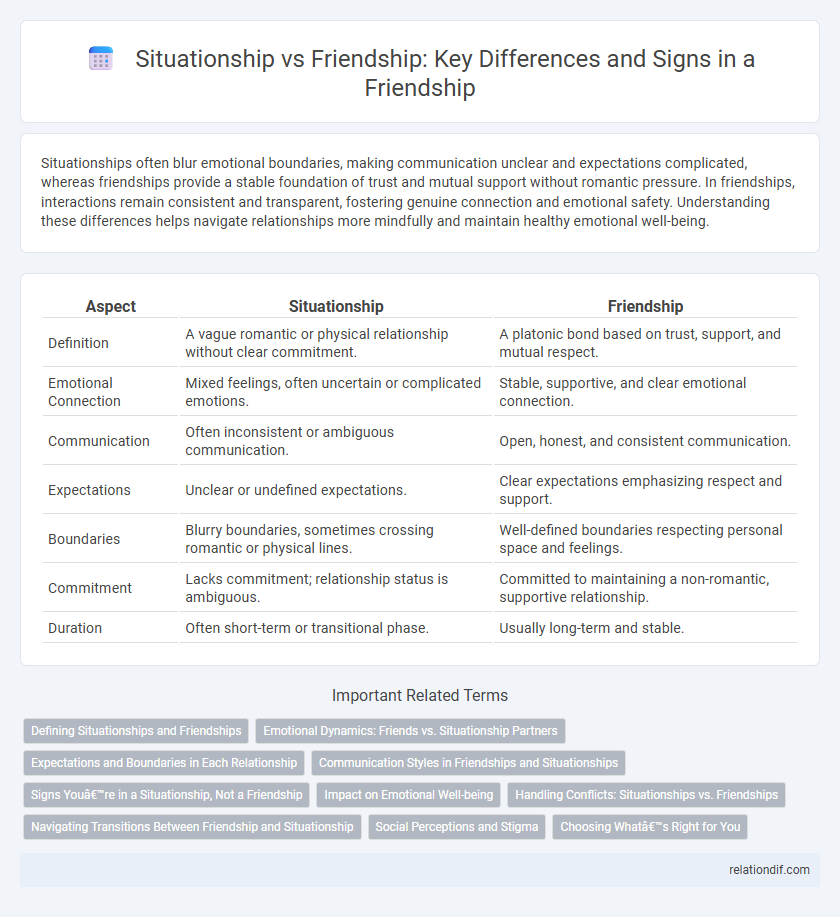Situationships often blur emotional boundaries, making communication unclear and expectations complicated, whereas friendships provide a stable foundation of trust and mutual support without romantic pressure. In friendships, interactions remain consistent and transparent, fostering genuine connection and emotional safety. Understanding these differences helps navigate relationships more mindfully and maintain healthy emotional well-being.
Table of Comparison
| Aspect | Situationship | Friendship |
|---|---|---|
| Definition | A vague romantic or physical relationship without clear commitment. | A platonic bond based on trust, support, and mutual respect. |
| Emotional Connection | Mixed feelings, often uncertain or complicated emotions. | Stable, supportive, and clear emotional connection. |
| Communication | Often inconsistent or ambiguous communication. | Open, honest, and consistent communication. |
| Expectations | Unclear or undefined expectations. | Clear expectations emphasizing respect and support. |
| Boundaries | Blurry boundaries, sometimes crossing romantic or physical lines. | Well-defined boundaries respecting personal space and feelings. |
| Commitment | Lacks commitment; relationship status is ambiguous. | Committed to maintaining a non-romantic, supportive relationship. |
| Duration | Often short-term or transitional phase. | Usually long-term and stable. |
Defining Situationships and Friendships
Situationships are ambiguous relationships lacking clear labels, often characterized by emotional intimacy without commitment, whereas friendships are mutual bonds based on trust, support, and consistent interaction without romantic expectations. Defining situationships involves recognizing fluctuating boundaries and unspoken expectations, while friendships maintain stable boundaries and transparent communication. Understanding these distinctions helps individuals navigate emotional connections and set appropriate relationship goals.
Emotional Dynamics: Friends vs. Situationship Partners
Friendship is built on mutual trust, consistent support, and clear boundaries that nurture emotional stability, while situationships often involve ambiguous feelings, fluctuating commitment, and uncertain expectations. Emotional dynamics in friendships prioritize open communication and long-term reliability, contrasting with the sometimes intense but unstable emotional highs and lows characteristic of situationships. Understanding these differences helps individuals navigate relationships with clarity and emotional well-being.
Expectations and Boundaries in Each Relationship
Situationships often carry ambiguous expectations where emotional intimacy blurs romantic intentions, making boundaries unclear and frequently shifting. In contrast, friendships maintain clearer boundaries with mutual understanding centered on trust, support, and non-romantic connection. Defining expectations early in situationships prevents misunderstandings, while friendships thrive on consistent respect for personal space and shared experiences.
Communication Styles in Friendships and Situationships
Communication styles in friendships often emphasize openness, mutual support, and clear boundaries, fostering trust and emotional security. In situationships, communication tends to be more ambiguous and inconsistent, with mixed signals and unspoken expectations creating potential confusion and emotional strain. Understanding these distinct communication patterns helps clarify relationship goals and manage personal boundaries effectively.
Signs You’re in a Situationship, Not a Friendship
Blurred boundaries and inconsistent communication are key signs you're in a situationship, not a friendship. Emotional intimacy without clear commitment or defined expectations often indicates a situationship dynamic. Frequent mixed signals and unpredictable availability further distinguish situationships from the reliable support found in genuine friendships.
Impact on Emotional Well-being
Situationships often create emotional uncertainty and stress due to their ambiguous nature and lack of clear boundaries, which can negatively impact mental health. Friendship offers stable emotional support, trust, and open communication, fostering a sense of security and well-being. Studies show that reliable social connections in friendships significantly reduce anxiety and depression, enhancing overall emotional resilience.
Handling Conflicts: Situationships vs. Friendships
Handling conflicts in situationships often involves navigating unclear boundaries and emotional ambiguity, leading to increased tension and miscommunication. In contrast, friendships tend to have clearer communication patterns and established mutual respect, facilitating more constructive conflict resolution. Emotional transparency and trust serve as foundational elements that differentiate how conflicts are managed in friendships versus situationships.
Navigating Transitions Between Friendship and Situationship
Navigating transitions between friendship and situationship involves clear communication and setting boundaries to prevent misunderstandings. Recognizing emotional cues and aligning expectations helps maintain trust while exploring deeper connections without jeopardizing the original friendship. Understanding the differences between casual romantic interest and platonic support is crucial for preserving both personal well-being and relationship integrity.
Social Perceptions and Stigma
Situationships often face social stigma due to their ambiguous nature, leading to uncertainty and judgment from external observers compared to the clear, socially accepted boundaries of friendship. Friendships are widely perceived as stable, platonic relationships free from romantic expectations, which reduces societal scrutiny and fosters social legitimacy. The blurred lines in situationships challenge traditional relationship norms, resulting in mixed perceptions that can affect individual reputations and social standing.
Choosing What’s Right for You
Choosing what's right for you in situationship versus friendship requires evaluating emotional needs and long-term goals. Situationships often blur boundaries and create uncertainty, while friendships provide consistent support and trust. Prioritizing clear communication and self-awareness helps ensure healthier, more fulfilling connections tailored to individual preferences.
situationship vs friendship Infographic

 relationdif.com
relationdif.com